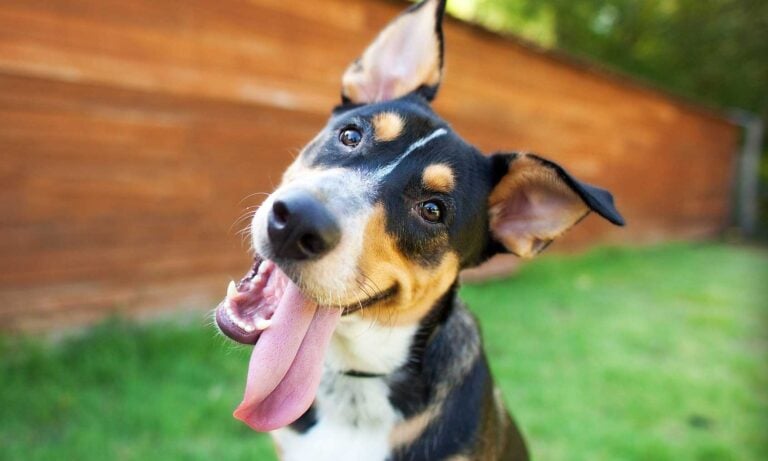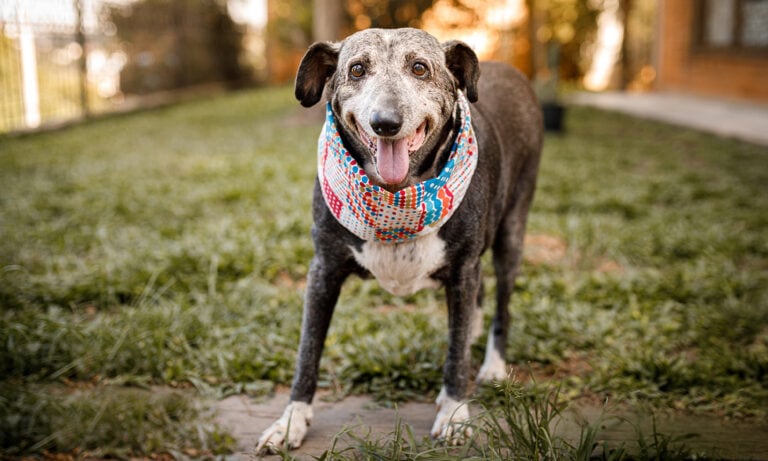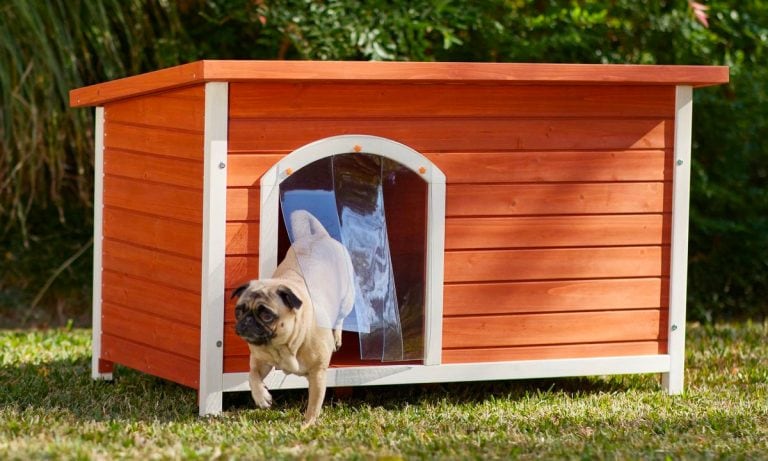How old is my dog in human years? It’s a question new puppy parents and experienced dog parents alike ask about their canine companions. And while you’ve probably heard that one dog year equals seven human years, converting dog years to human years for a relatively accurate calculation is a bit more complicated.
Regardless of whether you’ve had your dog since they were a puppy or adopted them when they were a few years old, getting an idea of their age helps us better understand our canine companions; their needs as they grow older; and how to provide the best care for every life stage.
In This Guide:
How to Calculate Dog Years to Human Years
While it may be easier to follow the 7:1 ratio for a guesstimate of your dog’s age, there are more accurate methods to follow nowadays, based on copious research on aging in dogs.
The American Veterinary Medical Association (AVMA) suggests the following as a general guideline for calculating dog years to human years:
- The first year of a medium-size dog’s life is equivalent to 15 human years.
- The second year is equivalent to about nine human years.
- Every subsequent year is equivalent to about five human years.
Additionally (and interestingly), researchers at the University of California, San Diego conducted a 2019 study on DNA methylation patterns of more than 100 Labrador Retrievers between 4 weeks old and 16 years old, and compared their findings to humans’ methylation patterns.
In their research, they developed a new and improved equation for a more accurate calculation of dog years to human years that requires, well, more math and the help of a calculator.
This formula is (human_age = 16 ln(dog_age) + 31). To find your dog’s age in human years, multiply the natural algorithm, or “ln,” of your dog’s age by 16, then add 31.
For example, if you have a 5-year-old dog, you would plug “16 ln(5) + 31” into a calculator and end up with 56.8—meaning that your furry friend would be on their way to receiving Social Security retirement benefits if they were human!
Because the study was based on Labrador Retrievers, the calculation may not be accurate for other breeds. However, it’s worth noting this exciting study.
Dog Age Chart
Below is an estimate of a dog’s age based on their size, according to the American Animal Hospital Association (AAHA).
1
15
15
15
15
2
24
24
24
24
3
28
28
30
32
4
32
33
35
37
5
36
37
40
42
6
40
42
45
49
7
44
47
50
56
8
48
51
55
64
9
52
56
61
71
10
56
60
66
78
11
60
65
72
86
12
64
69
77
93
13
68
74
82
101
14
72
78
88
108
15
76
83
93
115
16
80
87
99
123
17
84
92
104
-
18
88
96
109
-
19
92
101
115
-
20
96
105
120
-
How Do Dogs Age?
“Dogs, like humans, go through different stages of life as they age,” says Dr. Bethany Hsia, DVM, co-founder of CodaPet in Clovis, California. As much as we wish dogs could age at the same rate we do, they age much faster in comparison.
These stages of development—and ultimately, the aging process—can vary in duration and characteristics among different breeds, adds Dr. Nicole Savageau, VMD, a veterinarian with national mobile pet care service The Vets in Austin, Texas.
Dr. Savageau and Dr. Hsia explain how a dog’s lifespan is categorized into multiple life stages, including:
- Puppyhood (0-1 year): Hello, puppy breath! This is when dogs are considered puppies. At this point in their lives, they experience rapid physical and mental growth, Dr. Hsia says. The world is new, and there’s a lot to learn, from socialization and basic training to getting acclimated to routines.
- Adolescence (1-2 years): In adolescence, young dogs are no longer puppies, but are still growing in their physical development and behavioral maturation. “They may exhibit some childish or teenage-like behavior,” Dr. Hsia says, “such as increased independence and testing boundaries.”
- Adulthood (2-6 years): This stage is when dogs are considered to be in their prime, and are fully mature both physically and mentally. They’re in good health, active and energetic, Dr. Hsia says.
- Seniority (7+ years): Dogs typically enter their golden years around 7 years old. However, this age varies. Dr. Hsia and Dr. Savageau say dogs at this age may start showing signs of aging, like decreased activity, gray hair and potential health issues.
In the previously mentioned 2019 study, researchers also compared both dogs’ and humans’ major physiological milestones during their development and lifetime aging to provide further insight as to how our furry friends age.
Below are the comparisons between dogs and humans:
First 8 weeks
First 9 months
2-6 months
1-12 years
6 months-2 years
12-25 years
2-7 years
25-50 years
7-12 years
70 years
How Long Do Dogs Live?
On average, dogs live 10-13 years, says Dr. Hsia—but this can vary depending on factors like breed; environment genetics; health conditions specific to certain breeds; size; and overall health care.
“Small breeds may live anywhere from 12 to 16 years or even longer, while medium-size breeds typically live around 10 to 12 years,” says Dr. Savageau. “Larger breeds generally have shorter lifespans, ranging from seven to 10 years.”
According to Dr. Hsia and Dr. Savageau, smaller breeds typically have a longer lifespan for several reasons, such as:
- Having a high mass-specific metabolic rate, which can lead to a slower aging process.
- Being less prone to health issues, like joint problems and heart conditions, that can shorten their lifespan.
- Their genetics, which can play a significant role in determining lifespan and may contribute to longevity.
Learn more about how long dogs live.
When Are Dogs Considered Seniors?
A dog is considered a senior around 7-9 years old. However, this can vary based on size and breed, Dr. Savageau says.
The AVMA breaks down the average age when dogs become seniors based on their size, using data from the AKC:
- Small or toy breeds (under 20 pounds): 8-11 years
- Medium breeds (20-50 pounds): 8-10 years
- Large breeds (50-90 pounds): 8-9 years
- Giant breeds (over 90 pounds): 6-7 years
These ages were derived from what’s considered to be the last 25 percent of the estimated lifespan for a dog’s breed, according to the AAHA.
Dr. Savageau says the stage of seniority can vary significantly among breeds, with small dogs typically having a longer period of adulthood before reaching their golden years compared to large dogs. For example, a 7-year-old Chihuahua may still be relatively young and active, while a 7-year-old Saint Bernard would likely be considered a senior due to the shorter average lifespan of larger dogs, Dr. Hsia says.
How to Help Your Dog Live a Long, Healthy Life
As pet parents, there are steps we can take to help your dog live longer and feel younger. Follow these tips from our experts:
- Feed a balanced diet. This should be a nutritious diet that’s appropriate for your dog’s age, size and health needs. For more information, consult your veterinarian to learn the best options for your one-of-a-kind canine.
- Exercise them regularly to maintain their physical health. Whether it’s daily walks, indoor playtime sessions or going for outdoor adventures, regular exercise can help your dog maintain a healthy weight and promote overall well-being.
- Keep them entertained and busy with mental stimulation. Interactive toys, training exercises and enrichment activities keep your dog engaged, ultimately preventing boredom and cognitive decline.
- Clean their teeth. By practicing good oral hygiene with regular brushing, dental chews and treats, dental toys and annual dental exams, you can reduce plaque buildup and the risk of tooth loss, bad breath, pain and dental disease. Get more tips on keeping your dog’s teeth clean.
- Maintain a safe environment. Providing shelter from extreme weather conditions and minimizing exposure to potential hazards, like toxins, is important to create a safe, comfortable environment for your dog, Dr. Savageau says.
- Schedule regular vet visits. Routine vet visits for vaccinations, annual checkups and preventative care can help keep your dog healthy and catch health issues early.
- Provide ample quality time and affection. “Spend quality time with your dog, providing love, attention and companionship, which contribute to their emotional well-being and overall happiness,” Dr. Savageau says.
It’s a privilege to grow older with our dogs. By being informed of their age and needs, pet parents can help them thrive from puppyhood to seniority. For more tips, tricks and helpful checklists on how to ensure your dog lives a long, happy life, check out our pet wellness guide.
Expert input provided by Dr. Bethany Hsia, DVM, co-founder of CodaPet in Clovis, California; and Dr. Nicole Savageau, VMD, a veterinarian with The Vets in Austin, Texas.
More on caring for your dog:
Share:












